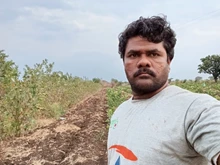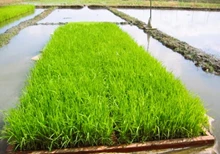
We all have heard of organic vegetables, but unsure of whether the vegetables that we get from the markets are free from chemicals or not. Everyone can have their own vegetable farm at home. Here are some tips to grow vegetables at your house:
Tomato
Tomatoes are linked to many health benefits, including reduced risk of heart disease and cancer. They are also a great source of vitamin C, potassium, folate, and vitamin K. Here is how you can grow them at home:
- Prepare the potting mix by mixing sand, red soil, compost, cocopeat and neem cake in the ratio 30:20:20:20:10.
- Sow the tomato seeds in the potting mix, equidistant from one another. Sprinkle with water after sowing.
- Mulch the seeds with hay/dried leaves and cover partially to create a semi-greenhouse effect.
- Continue spraying water every 2-3 days till the seeds sprout. After four sets of true leaves appear, transplant the sapling into a big pot and stake it with sticks on all 4 sides.
- Add a handful of compost to the tomato plant once in a week till it flowers.
- Since the tomato plant is vulnerable to attacks by mealybugs and leaf miners, spray diluted neem oil in the dish-wash solution once in 15 days.
Chilli Pepper
Chilli peppers are widely used in many cuisines as a spice to add heat to dishes. They help in fighting inflammation and prevent cardiovascular diseases.
- Mix equal amounts of cocopeat, compost and perlite (or tiny pieces of thermocol).
- Put the potting mix in a small pot and soak it in ample water overnight.
- Next day, press each of the chilli seeds gently into the soft soil and cover it with mulch/hay.
- Water daily till the seeds germinate into tiny saplings.
- As soon as the leaves appear, transfer each sapling to a bigger pot with a height of at least 20 inches.
- Water daily till the plant flowers. Reduce the frequency of watering after flowering happens. Harvest fresh chillies when fruited.

Coriander
Coriander is a wonderful source of dietary fibre, manganese, iron and magnesium as well. In addition, coriander leaves are rich in Vitamin C, Vitamin K and protein.
- Take a handful of coriander seeds and press them slightly to break them into two. Soak the broken seeds in water overnight.
- Mix sand, red soil, cocopeat, neem cake and compost in equal quantities.
- Drain the above potting mix well and scrape lines through it to sow the seeds.
- Spread the seeds evenly along the scraped lines. Cover the seeds lightly with soil and dry leaves and sprinkle little water.
- After the seeds have sprouted, spray with diluted buttermilk once every 15 days.
- Harvest the Coriander once it’s ready.
Bitter Gourd
Bitter gourd juice contains a train of important nutrients ranging from iron, magnesium and vitamin to potassium and vitamin C. An excellent source of dietary fibre, it also contains twice the calcium of spinach, beta-carotene of broccoli, and the potassium of a banana.
- Soak the seeds overnight and sow them in small pots, such that only two seeds are sowed together.
- Prepare a potting mix with 30 per cent red soil, 20 per cent compost, 20 per cent cocopeat, 20 per cent sand and 10 per cent neem cake. Water this mix thoroughly and keep it aside.
- Gently remove a sapling from the small pot with the soil and transfer it into a bigger pot.
- Insert sticks into the soil to support the creeper.
- Keep pinching the side stems so that the main stem grows up to 6-7 feet. Add a handful of compost once every week.
- Remove the leaves near the base of the plant to avoid any infection. Pinch the tip of the plant once it reaches a height of 7-8 feet.
- Once the female flowers appear, hand-pollinate them with the male flowers. Female flowers can be identified by the presence of a small fruit beneath them, which is absent in the male flowers. Cover the pollinated flower to avoid attack by fruit flies.
- Harvest the bitter gourds once ready. For procuring seeds, leave one or two bitter gourds on the plant itself till they are completely yellow.

Cucumber
Cucumber has 4 per cent of the daily potassium, 3 per cent of the daily fiber and 4 per cent of the daily vitamin C intake required. They also provide small amounts of vitamin K, vitamin C, magnesium, potassium, manganese and vitamin A.
- Soak cucumber seeds overnight before sowing them.
- Use a good quality potting mix with one part each of soil, compost, perlite and cocopeat.
- Using thumb, make 5 mm depressions in the soil to sow the cucumber seeds. Cover with loose soil and water gently so as not to expose the seeds. The soil should be kept moist at all times.
- After the seeds germinate and at least four true leaves appear, transfer the saplings into bigger pots.
- Expose the plant to direct sunlight at least 6-8 hours in a day.
- Manual pollination by hand might be required to ensure fruiting. Harvest the fruits when ready.
Mint
Mint provides a refreshing taste that can make the mouth feel clean. It also has antibacterial and anti-inflammatory properties, which can improve teeth and gum health. The act of chewing also helps with cleaning the mouth and teeth.
- Keep aside a few sprigs of mint from a fresh bunch you got from the market.
- Choose a healthy, thick stem and make a cut at around 15 cm along the length, below the node. Remove a few leaves gently from the cutting.
- Put a few such cuttings in a glass of clean water. Keep indoors, away from sunlight.
- In a few days, the cuttings will sprout new leaves and grow roots. You can use the leaves directly or transplant the saplings into fresh potting soil.
Spinach
Spinach is also an excellent source of vitamin K, vitamin A, vitamin C and folate as well as being a good source of manganese, magnesium, iron and vitamin B2. Vitamin K is important for maintaining bone health and it is difficult to find vegetables richer in vitamin K than these.
- Prepare a potting mix using well-drained loamy soil enriched with organic compost.
- Sow the spinach seeds gently in rows or blocks around 1-1.5 feet apart, cover loosely with soil and water well till germination.
- Once true leaves start appearing, space out the saplings around six inches apart to allow ample space for each plant.
- Keep under direct daytime exposure to sunlight or partial shade.
- Pick the leaves whenever needed. Leaves will continue to regrow until the end of the season.
Radish
Red radishes are packed with Vitamins E, A, C, B6, and K, also it's high on antioxidants, fibre, zinc, potassium, phosphorous, magnesium, copper, calcium, iron and manganese. And each of these is known to keep our body in good working condition.










